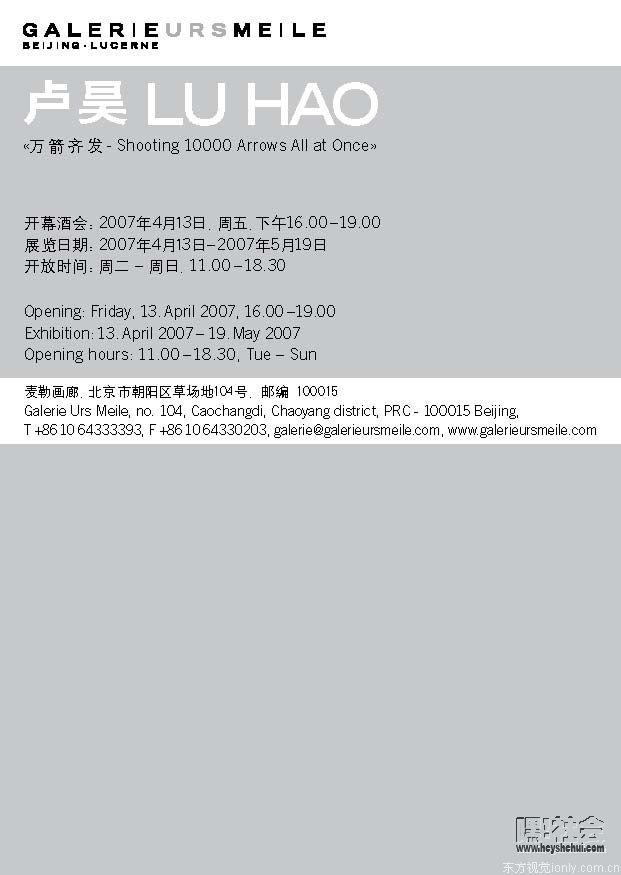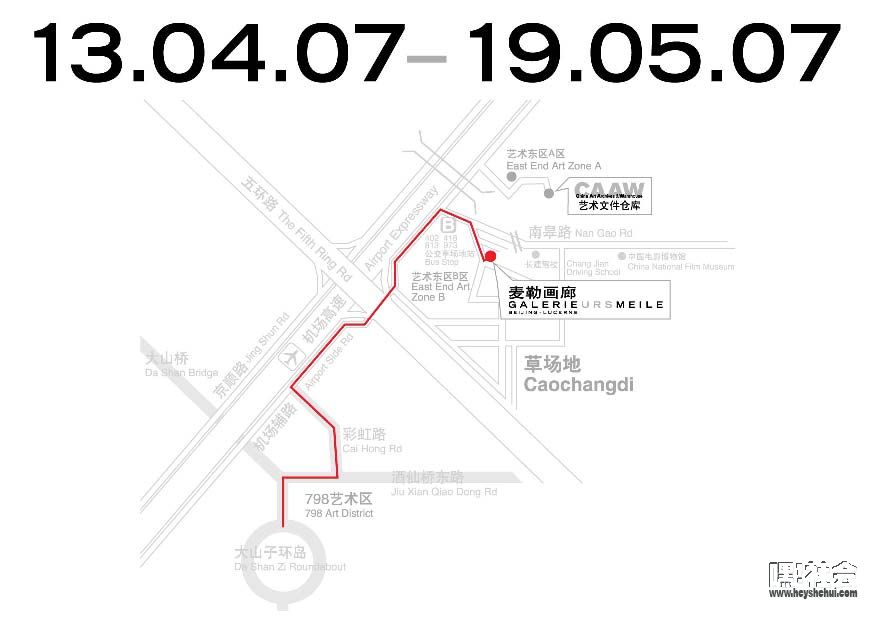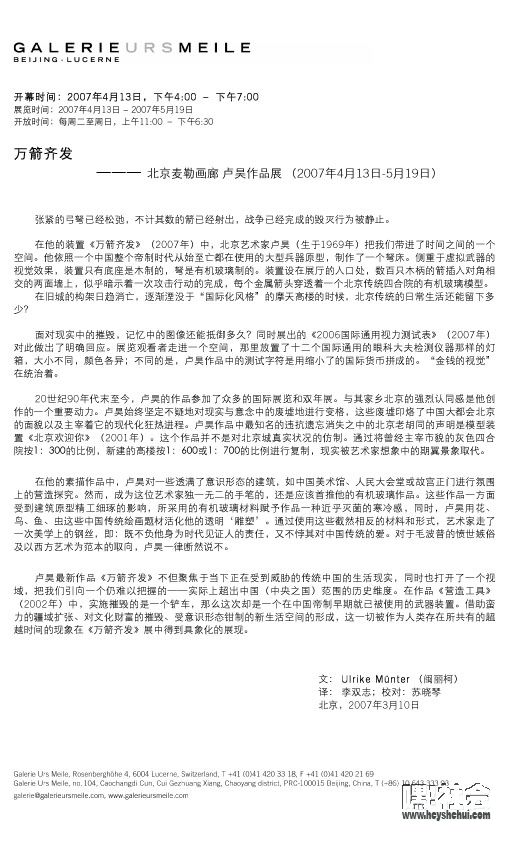[attachment=40032]
[attachment=40033]
[attachment=40033]
Exhibition at the Galerie Urs Meile, Beijing
麦勒画廊,北京个展
Opening: Friday, 13 April 2007, 4:00 p.m. - 7:00 p.m.
开幕式:2007年4月13日 星期五,下午 4:00 - 7:00
Lu Hao <Shooting 10000 Arrows All at Once>
卢昊《万剑齐发》
Exhibition: 13 April - 19 May, 2007
画展时间: 2007年4月13日 - 5月19日
Tuesday to Saturday 11:00 a.m. - 6:30 p.m.
每周二至周六 上午 11:00 - 下午 6:30
Galerie Urs Meile, Beijing-Lucerne
麦勒画廊,北京-卢森
Galerie Urs Meile, Beijing
No.104 Caochangdi, Chaoyang District,
Beijing 100015, China
中国北京市草场地104号,邮编100015
[url]www.galerieursmeile.com

[attachment=40035]
[attachment=40034]

[attachment=40034]


[attachment=40036]
[attachment=40037]
开幕时间:2007年4月13日,下午4:00 - 下午7:00
展览时间:2007年4月13日 – 2007年5月19日
开放时间:每周二至周日,上午11:00 - 下午6:30
万箭齐发
——— 北京麦勒画廊 卢昊作品展 (2007年4月13日-5月19日)
张紧的弓弩已经松弛,不计其数的箭已经射出,战争已经完成的毁灭行为被静止。
在他的装置《万箭齐发》(2007年)中,北京艺术家卢昊(生于1969年)把我们带进了时间之间的一个
空间。他依照一个中国整个帝制时代从始至亡都在使用的大型兵器原型,制作了一个弩床。侧重于虚拟武器的
视觉效果,装置只有底座是木制的,弩是有机玻璃制的。装置设在展厅的入口处,数百只木柄的箭插入对角相
交的两面墙上,似乎暗示着一次攻击行动的完成,每个金属箭头穿透着一个北京传统四合院的有机玻璃模型。
在旧城的构架日趋消亡,逐渐湮没于“国际化风格”的摩天高楼的时候,北京传统的日常生活还能留下多
少?
面对现实中的摧毁,记忆中的图像还能抵御多久?同时展出的《2006国际通用视力测试表》(2007年)
对此做出了明确回应。展览观看者走进一个空间,那里放置了十二个国际通用的眼科大夫检测仪器那样的灯
箱,大小不同,颜色各异;不同的是,卢昊作品中的测试字符是用缩小了的国际货币拼成的。“金钱的视觉”
在统治着。
20世纪90年代末至今,卢昊的作品参加了众多的国际展览和双年展。与其家乡北京的强烈认同感是他创
作的一个重要动力。卢昊始终坚定不疑地对现实与意念中的废墟地进行变格,这些废墟印烙了中国大都会北京
的面貌以及主宰着它的现代化狂热进程。卢昊作品中最知名的违抗遗忘消失之中的北京老胡同的声明是模型装
置《北京欢迎你》(2001年)。这个作品并不是对北京城真实状况的仿制。通过将曾经主宰市貌的灰色四合
院按1:300的比例,新建的高楼按1:600或1:700的比例进行复制,现实被艺术家想象中的期翼景象取代。
在他的素描作品中,卢昊对一些透满了意识形态的建筑,如中国美术馆、人民大会堂或故宫正门进行氛围
上的营造探究。然而,成为这位艺术家独一无二的手笔的,还是应该首推他的有机玻璃作品。这些作品一方面
受到建筑原型精工细琢的影响,所采用的有机玻璃材料赋予作品一种近乎灭菌的寒冷感,同时,卢昊用花、
鸟、鱼、虫这些中国传统绘画题材活化他的透明‘雕塑’。通过使用这些截然相反的材料和形式,艺术家走了
一次美学上的钢丝,即:既不负他身为时代见证人的责任,又不悖其对中国传统的爱。对于毛波普的愤世嫉俗
及以西方艺术为范本的取向,卢昊一律断然说不。
卢昊最新作品《万箭齐发》不但聚焦于当下正在受到威胁的传统中国的生活现实,同时也打开了一个视
域,把我们引向一个仍难以把握的——实际上超出中国(中央之国)范围的历史维度。在作品《营造工具》
(2002年)中,实施摧毁的是一个铲车,那么这次却是一个在中国帝制早期就已被使用的武器装置。借助蛮
力的疆域扩张、对文化财富的摧毁、受意识形态钳制的新生活空间的形成,这一切被作为人类存在所共有的超
越时间的现象在《万箭齐发》展中得到具象化的展现。
文: Ulrike Münter (闽丽柯)
译: 李双志;校对:苏晓琴
北京,2007年3月10日
Opening: April 13, 2007, 4:00 pm – 7:00 pm
Exhibition: April 13 – May 19, 2007
Opening Hour s: Tuesday – Sunday, 11:00 am – 6:30 pm
Lu Hao – Shooting 10,000 Arrows All at Once
For images and additional information, contact: [email]beijing@galerieursmeile.com
The strap of the crossbow hangs loose, innumerable arrows have been shot, the belligerent act of destruction
appears arrested in an advanced state.
In his installation Shooting 10,000 Arrows All at Once (2007), Beijing artist Lu Hao (b. 1969) takes us into a space
between times. To create the work, the artist has reconstructed a launching platform mounted with a crossbow, a
bulky contraption of the type used from the early empires well into the Ming and Manchu dynasties. Emphasizing
the virtual dimension of this imitation battle weapon, only the chassis is made of wood, while the crossbow device
is made of transparent Plexiglas. It is located near the entrance of the exhibition room, and there are hundreds of
wooden arrows stuck in the diagonally opposite walls. This suggests an attack that is already over. The metal
arrowheads have sunk themselves into models of traditional Beijing courtyard houses. There is little room in Lu
Hao’s installation for the sort of idealism that movie director Zhang Yimou projects in his blockbuster Hero. While
in Zhang’s film about the Qin emperor Qin Shihuangdi (221 BC - 207 BC), the grand master of calligraphy can
proclaim the immortality of Chinese tradition even in a hail of arrows from his enemies, such certainty is a lot more
debatable in this artwork.
What is left of the time-honored, daily life of Beijing when the old urban infrastructure is quickly being obliterated
and replaced by ‘international style’ high-rise skylines? How long can the images in our memory resist factual
destruction? The installation 2006 New Visual Acuity Chart for General Use (2006), also included in this exhibtion,
says it loud and clear. Here, the visitor enters a room which displays a dozen fluorescent light boxes in various
sizes and colors, featuring the ‘tumbling E’ which is common in optometrists’ offices all over the world. The
optotypes in Lu Hao’s pieces, however, are made up of scaled-down banknotes of international currencies. It is
the ‘vision of money’ that has prevailed.
Lu Hao’s works have been shown in numerous international exhibitions and biennials ever since the late 1990s. A
major motor of his creative work is his strong identification with his native town Beijing. With superior
imperturbability, Lu Hao probes the concrete and the conceptual rubble fields that have been shaping the face of
the Chinese mega-city as well as the modernization urge that dominates it. His most well-known statement against
oblivion, against the gradual vanishing of the traditional Beijing hutong alleyways, is the model-type installation
Beijing Welcomes You (2001). However, it is not a representation of the real city center. By replicating the oldstyle
buildings at the scale of 1:200, but the more recent ones at 1:600 or 1:700, the artist lets his wishful
thinking take the place of actual reality.
In his drawings, Lu Hao explores the atmospheric impact of ideologically connoted buildings such as Beijing’s
National Art Gallery, the Great Hall of the People and the entrance to the Forbidden City. But it is above all the
Plexiglas objects that have become this artist’s unmistakable signature. On the one hand, these works are
characterized by the meticulousness of an architect and by their almost aseptically cold modeling material,
Plexiglas. On the other, Lu Hao animates his transparent ‘sculptures’ with flowers, birds, insects and fish, all of
which are also popular motifs in traditional Chinese painting. Through this interaction of highly antithetical
materials and forms, the artist succeeds in walking an aesthetic tightrope: he manages to do justice both to his
responsibility as a witness of his time and to his love of Chinese traditional fine art. He clearly rejects cynical
approaches à la "Politcal Pop," just as he does not condone emulating the examples of Western art.
Lu Hao’s most recent piece, Shooting 10,000 Arrows All at Once, not only puts into focus the currently
endangered relics of the traditional Chinese lifestyle, it also opens our eyes to rather elusive historical dimensions
– quite beyond China, in fact. While in his work Construction Device (2002), the agent of demolishment was the
shovel of an excavator, this time we are confronted with a piece of ancient weaponry, used during the early
dynasties. In Shooting 10000 Arrows All at Once, the scenario of violent appropriation of territory, devastation of
cultural assets and the ideologically conditioned development of new environments is visualized as a timeless
phenomenon of human existence.
by Ul rike Münter
Translation: Werner Richter

[attachment=40037]
开幕时间:2007年4月13日,下午4:00 - 下午7:00
展览时间:2007年4月13日 – 2007年5月19日
开放时间:每周二至周日,上午11:00 - 下午6:30
万箭齐发
——— 北京麦勒画廊 卢昊作品展 (2007年4月13日-5月19日)
张紧的弓弩已经松弛,不计其数的箭已经射出,战争已经完成的毁灭行为被静止。
在他的装置《万箭齐发》(2007年)中,北京艺术家卢昊(生于1969年)把我们带进了时间之间的一个
空间。他依照一个中国整个帝制时代从始至亡都在使用的大型兵器原型,制作了一个弩床。侧重于虚拟武器的
视觉效果,装置只有底座是木制的,弩是有机玻璃制的。装置设在展厅的入口处,数百只木柄的箭插入对角相
交的两面墙上,似乎暗示着一次攻击行动的完成,每个金属箭头穿透着一个北京传统四合院的有机玻璃模型。
在旧城的构架日趋消亡,逐渐湮没于“国际化风格”的摩天高楼的时候,北京传统的日常生活还能留下多
少?
面对现实中的摧毁,记忆中的图像还能抵御多久?同时展出的《2006国际通用视力测试表》(2007年)
对此做出了明确回应。展览观看者走进一个空间,那里放置了十二个国际通用的眼科大夫检测仪器那样的灯
箱,大小不同,颜色各异;不同的是,卢昊作品中的测试字符是用缩小了的国际货币拼成的。“金钱的视觉”
在统治着。
20世纪90年代末至今,卢昊的作品参加了众多的国际展览和双年展。与其家乡北京的强烈认同感是他创
作的一个重要动力。卢昊始终坚定不疑地对现实与意念中的废墟地进行变格,这些废墟印烙了中国大都会北京
的面貌以及主宰着它的现代化狂热进程。卢昊作品中最知名的违抗遗忘消失之中的北京老胡同的声明是模型装
置《北京欢迎你》(2001年)。这个作品并不是对北京城真实状况的仿制。通过将曾经主宰市貌的灰色四合
院按1:300的比例,新建的高楼按1:600或1:700的比例进行复制,现实被艺术家想象中的期翼景象取代。
在他的素描作品中,卢昊对一些透满了意识形态的建筑,如中国美术馆、人民大会堂或故宫正门进行氛围
上的营造探究。然而,成为这位艺术家独一无二的手笔的,还是应该首推他的有机玻璃作品。这些作品一方面
受到建筑原型精工细琢的影响,所采用的有机玻璃材料赋予作品一种近乎灭菌的寒冷感,同时,卢昊用花、
鸟、鱼、虫这些中国传统绘画题材活化他的透明‘雕塑’。通过使用这些截然相反的材料和形式,艺术家走了
一次美学上的钢丝,即:既不负他身为时代见证人的责任,又不悖其对中国传统的爱。对于毛波普的愤世嫉俗
及以西方艺术为范本的取向,卢昊一律断然说不。
卢昊最新作品《万箭齐发》不但聚焦于当下正在受到威胁的传统中国的生活现实,同时也打开了一个视
域,把我们引向一个仍难以把握的——实际上超出中国(中央之国)范围的历史维度。在作品《营造工具》
(2002年)中,实施摧毁的是一个铲车,那么这次却是一个在中国帝制早期就已被使用的武器装置。借助蛮
力的疆域扩张、对文化财富的摧毁、受意识形态钳制的新生活空间的形成,这一切被作为人类存在所共有的超
越时间的现象在《万箭齐发》展中得到具象化的展现。
文: Ulrike Münter (闽丽柯)
译: 李双志;校对:苏晓琴
北京,2007年3月10日
Opening: April 13, 2007, 4:00 pm – 7:00 pm
Exhibition: April 13 – May 19, 2007
Opening Hour s: Tuesday – Sunday, 11:00 am – 6:30 pm
Lu Hao – Shooting 10,000 Arrows All at Once
For images and additional information, contact: [email]beijing@galerieursmeile.com
The strap of the crossbow hangs loose, innumerable arrows have been shot, the belligerent act of destruction
appears arrested in an advanced state.
In his installation Shooting 10,000 Arrows All at Once (2007), Beijing artist Lu Hao (b. 1969) takes us into a space
between times. To create the work, the artist has reconstructed a launching platform mounted with a crossbow, a
bulky contraption of the type used from the early empires well into the Ming and Manchu dynasties. Emphasizing
the virtual dimension of this imitation battle weapon, only the chassis is made of wood, while the crossbow device
is made of transparent Plexiglas. It is located near the entrance of the exhibition room, and there are hundreds of
wooden arrows stuck in the diagonally opposite walls. This suggests an attack that is already over. The metal
arrowheads have sunk themselves into models of traditional Beijing courtyard houses. There is little room in Lu
Hao’s installation for the sort of idealism that movie director Zhang Yimou projects in his blockbuster Hero. While
in Zhang’s film about the Qin emperor Qin Shihuangdi (221 BC - 207 BC), the grand master of calligraphy can
proclaim the immortality of Chinese tradition even in a hail of arrows from his enemies, such certainty is a lot more
debatable in this artwork.
What is left of the time-honored, daily life of Beijing when the old urban infrastructure is quickly being obliterated
and replaced by ‘international style’ high-rise skylines? How long can the images in our memory resist factual
destruction? The installation 2006 New Visual Acuity Chart for General Use (2006), also included in this exhibtion,
says it loud and clear. Here, the visitor enters a room which displays a dozen fluorescent light boxes in various
sizes and colors, featuring the ‘tumbling E’ which is common in optometrists’ offices all over the world. The
optotypes in Lu Hao’s pieces, however, are made up of scaled-down banknotes of international currencies. It is
the ‘vision of money’ that has prevailed.
Lu Hao’s works have been shown in numerous international exhibitions and biennials ever since the late 1990s. A
major motor of his creative work is his strong identification with his native town Beijing. With superior
imperturbability, Lu Hao probes the concrete and the conceptual rubble fields that have been shaping the face of
the Chinese mega-city as well as the modernization urge that dominates it. His most well-known statement against
oblivion, against the gradual vanishing of the traditional Beijing hutong alleyways, is the model-type installation
Beijing Welcomes You (2001). However, it is not a representation of the real city center. By replicating the oldstyle
buildings at the scale of 1:200, but the more recent ones at 1:600 or 1:700, the artist lets his wishful
thinking take the place of actual reality.
In his drawings, Lu Hao explores the atmospheric impact of ideologically connoted buildings such as Beijing’s
National Art Gallery, the Great Hall of the People and the entrance to the Forbidden City. But it is above all the
Plexiglas objects that have become this artist’s unmistakable signature. On the one hand, these works are
characterized by the meticulousness of an architect and by their almost aseptically cold modeling material,
Plexiglas. On the other, Lu Hao animates his transparent ‘sculptures’ with flowers, birds, insects and fish, all of
which are also popular motifs in traditional Chinese painting. Through this interaction of highly antithetical
materials and forms, the artist succeeds in walking an aesthetic tightrope: he manages to do justice both to his
responsibility as a witness of his time and to his love of Chinese traditional fine art. He clearly rejects cynical
approaches à la "Politcal Pop," just as he does not condone emulating the examples of Western art.
Lu Hao’s most recent piece, Shooting 10,000 Arrows All at Once, not only puts into focus the currently
endangered relics of the traditional Chinese lifestyle, it also opens our eyes to rather elusive historical dimensions
– quite beyond China, in fact. While in his work Construction Device (2002), the agent of demolishment was the
shovel of an excavator, this time we are confronted with a piece of ancient weaponry, used during the early
dynasties. In Shooting 10000 Arrows All at Once, the scenario of violent appropriation of territory, devastation of
cultural assets and the ideologically conditioned development of new environments is visualized as a timeless
phenomenon of human existence.
by Ul rike Münter
Translation: Werner Richter


哦啊啊啊
听说他收到今年卡塞尔的邀请了